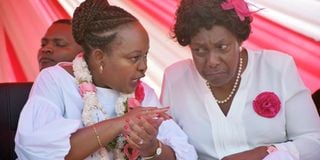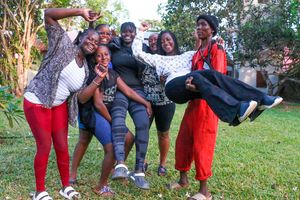One-third gender rule in Parliament still a mirage

When Grace Akech Onyango entered the hallowed precincts of Parliament on January 6, 1970, she was walking into the annals of history.
She became the first female MP, hardly seven years after the country attained independence, and about five years having been elected the first female Mayor of Kisumu in 1965 after trouncing six male competitors.
Ms Onyango’s entry into the August House at that time in history opened the gates for other women to get into politics.
Here she was the only woman in a 158-member House of men. And her performance was sterling, a fact attested to by being elected on a number of occasions, Temporary Deputy Speaker.
ASSISTANT MINISTER
In subsequent General Election, in 1974, two other women joined her – Julia Auma Ojiambo and Chelagat Mutai. Dr Ojiambo was to become the first female assistant minister – where she made a mark.
Ms Mutai, on the other hand, was to cut a name as radical politician who fiercely fought against the emergent political assassinations (Tom Mboya 1969, JM Kariuki 1975) under the Jomo Kenyatta regime as well as high-handedness in management of public affairs.
Here, she found company in the likes of Dr Chibule wa Tsuma, Lawrence Sifuna, Abuya, George Anyona, Koigi wa Wamwere and James Orengo, who had made a name as hard-tackling politicians.
Decades later and debate remains of women’s representation in national leadership. When in 2010, Kenya enacted a new Constitution whose foundation is expansion of civil liberties - among them inclusion and equity - women have not gotten their fair share.
GENDER RATIOS
The Constitution created and designated legislative positions for women to cure the historical and perennial imbalances – 47 Women Representatives – plus gender ratios in appointive and nomination positions. But that has not achieved the desired goal.
Constitutionally, there should be at least one-third gender representation in Parliament.
That is still a far cry. There are 23 females elected to Parliament, three at the Senate and 47 Women Representatives.
Additional 23 are nominated but cumulatively, they constitute only 23 per cent of Parliament. At the county level, only three women were elected governors – Anne Waiguru (Kirinyaga), Charity Ngilu (Kitui), Joyce Laboso (Bomet since deceased) out of the 47 counties. Even when opportunity afforded itself for remedies, only seven women were appointed Deputy Governors.
In the Cabinet of 21, there are only six women – Farida Karoney, Monica Juma, Margaret Kobia, Amina Mohamed, Sicily Kariuki and Raychelle Omamo.
WOMEN CANDIDATES
The gap remains wide. Only 96 women were elected to the County Assemblies against 1,334 men, some 650 were thus nominated to realise the gender rule.
On paper, there are 77 political parties but out of them, only six fielded women candidates at the 2017 General Election. All these point to glaring inequities in representative politics.
Studies by organisations, including the National Democracy Institute, show that women shun politics because of violence, expensive campaigns, cultural biases and personal inconveniences.
In a context where ethnicity rules supreme and electoral process commercialised, female candidates are disadvantaged. Yet no deliberate affirmative action has been put in place to even the playground.
Thus the one-third gender rule is an urgent imperative. Unfortunately, attempts to pass a motion that enforces the one-third gender rule has always floundered because of a sceptical male-dominated House that has intrinsic desire to stifle progress towards women’s full participation in governance.
PUBLIC DISCOURSE
Despite momentous leaps, the question of women representation and participation in politics and national leadership remains a critical subject of public discourse.
At the international level, several initiatives have been rolled out by the United Nations (UN) and other agencies to bridge the gender gaps. For instance, the UN convened the first World Conference in Mexico in 1975 whose agenda included expanding opportunities for women in politics.
It was followed by three others, Copenhagen in 1980, Nairobi 1985 and Beijing 1995; the latter considered a turning point in gender discourse.
Kenya was signatory to the declarations and played an instrumental role when one of the conferences was held in Nairobi.
Looking at all these, it’s been much talk but less action. Much has not been achieved and the impetus is greater now than ever before to realise gender equity in politics and national leadership.




